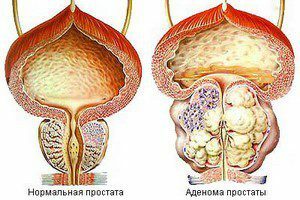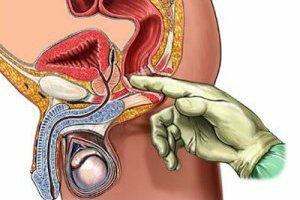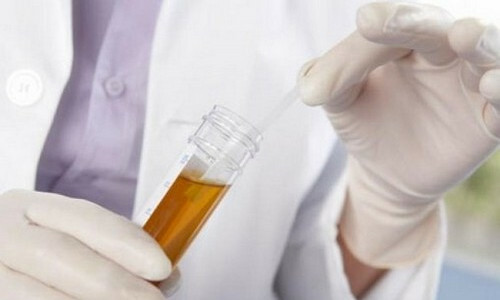BPH( benign prostatic hyperplasia) is an unpleasant problem for men. This ailment affects the glandular tissue of the organ. Under the influence of various causes, the layer begins to increase in size. The proliferation of tissue entails the appearance of nodular formations. Externally, hyperplasia is like a bunch of grapes. Thus there are various complications from the urinary system. These symptoms are the main reason for the patient to seek medical help.

In all cases, BPH requires research on the oncological nature. The main feature of the disease is the absence of additional branches. The patient does not have a metastatic process. With oncological lesions of the prostate, additional processes appear, which cause a rapid spread of cancer through the urinary system. But rejoice at a benign adenoma should not be. There is a risk that the disease will turn into an oncological form. To predetermine this phenomenon, it is necessary to constantly take an analysis for the presence of a prostatic specific substance. This hormone indicates the process of rebirth.
In any case, a man needs to constantly monitor his health. When there are various signs of the disease, you must immediately visit a specialist. Only a doctor can correctly determine the nature of hyperplasia and choose the appropriate treatment.
Risk group
Benign hyperplasia is often seen in men after 40 years. This disease rarely occurs in young people. This is due to certain processes in the body. The older the patient, the higher his risk of developing BPH.
Thanks to this feature, you must visit an expert every year. At medical researches it has been established, that the percentage parity of age and illness or disease increases or is enlarged to 70 years. If this number is 30% in patients at 40, then by 70 years it increases to 70%.
In many cases, this disease depends on the level of male hormones. The number of androgens in elderly men is significantly reduced. This causes the growth of estrogen. This substance is a female sex hormone. Against the background of an increase in the level of estrogen, pathological processes in various glands are activated. The main response occurs in the testicles and the prostate gland. Since the glandular tissue is contained only in the prostate, hyperplasia affects it.
When examining a group of patients with BPH, it was found that in many elderly men over the age of 75 the disease leads to atrophic phenomena in the organ. At younger patients atrophy is not observed.
Causes of development of the disease
Prostatic hyperplasia does not always have established causes. In some cases, the establishment of the negative factor that caused the disease does not occur. There are also the main causes that are accompanied by BPH:
-
 Autoimmune disorders;
Autoimmune disorders; - Damage to prostate tissue;
- Postponed viral diseases of the genitourinary system;
- Genetic predisposition;
- Severe supercooling or overheating of the body;
- Unreasonable livelihoods.
Some patients undergo an autoimmune attack. In a healthy person, this system performs the function of protection. When an organism attacks with various pathogenic microorganisms, antibodies are released into the blood. The antibody captures the antigen and removes it from the body in various ways. Under the influence of negative environmental phenomena, the work of this system may be disrupted. She begins to produce antibodies against her own cells. In this case, a sharp increase in antibodies in plasma is observed. Antibody attack of the glandular layer of the prostate gland is accompanied by hyperplasia of the organ.
In some cases, tissue damage occurs. It can occur against a background of previous surgical intervention or as a result of a fall. Trauma of the organ is accompanied by rupture or microcracks of the glandular layer. The organism strengthens metabolic processes for rapid recovery of the affected area. The process is accompanied by the active formation of new cells. The layer is actively expanding. Appears BPH.
The cause of the disease may become a previously transmitted disease of the viral etiology. Problems of the genitourinary system often cause various pathogens. Bacteria cause a disruption in the work of the tissues of the pelvic organs. At a constant vital activity of a pathogenic microbe a death of a part of cells occurs. The site is inhabited by bacteria. The products of their vital activity exert an irritating effect on the tissue. Inflammation forms on the damaged area. With bacterial infection of the prostate, inflammation can damage all of its parts. Inflamed tissues cause a change in the characteristics of the tissue. There is an increase in the glandular layer. Prolonged inflammation causes the development of BPH.
Many physicians tend to believe that prostatic hyperplasia often has a hereditary nature. Many patients suffering from this disease have elderly relatives with BPH.If there are such patients in the family, young men are recommended to visit the doctor regularly. Timely detection of pathology will help quickly get rid of it.
 Fans of bathhouses and winter walks should also beware. A sharp change in temperature in the small pelvis can cause hyperplasia. The temperature drop is accompanied by a sharp contraction of smooth muscles. This reduction causes a decrease in blood circulation in the prostate. Reduced delivery of blood leads to a lack of oxygen in the tissues. Oxygen starvation causes inflammation. The organ affects the ailment.
Fans of bathhouses and winter walks should also beware. A sharp change in temperature in the small pelvis can cause hyperplasia. The temperature drop is accompanied by a sharp contraction of smooth muscles. This reduction causes a decrease in blood circulation in the prostate. Reduced delivery of blood leads to a lack of oxygen in the tissues. Oxygen starvation causes inflammation. The organ affects the ailment.
Features of life can also affect the development of the disease. The focus should be on physical activity and human nutrition. Low motor activity affects the flow of blood to the internal organs. Due to this, the metabolic processes decrease. In the tissues, the production of new cells falls. In the presence of inflammation, this process is more active. The lowering of metabolic processes affects the development of inflammation. It affects the organs. Several ailments develop, including hyperplasia of the prostate.
The danger is also presented by the male's malnutrition. Many products cause a change in the vitamin-mineral balance. A change in the amount of these substances leads to hypovitaminosis. Against this background, there are various negative changes in the organs. It affects the reproductive system more. Reduction of vitamins leads to an imbalance in the hormonal system. The level of androgens varies. Reduction of these hormones leads to disruption of the prostate gland. It ceases to produce a sufficient amount of sperm fluid and atrophies. The process of reducing activity causes activation of growth of the glandular layer. There is the appearance of hyperplasia.
Negative influence is exerted by alcohol. Alcohol-containing liquids entail a violation of the basic functions of the nervous and vascular system. With a lack of blood, a part of the cells in the layer die. He can not fully exercise his function. The appearance of inflammation is accompanied by tissue proliferation. In the prostate gland develops hyperplasia.
Description of the pathology of
To understand what harm the affliction brings, it is necessary to know the processes taking place in the prostate. When hyperplasia, there is a violation of the function of the glandular layer. It lays the inside of the lobes of the organ. The prostate gland consists of three parts. The lobes are located under the sphincter of the bladder. In the center of the lobes is the urinary canal. The layer affected by hyperplasia surrounds the canal from all sides. When the nodular process develops, the channel localization is observed. This phenomenon is accompanied by a different deviation of the channel to the sides. There are several types of problem location:
-
 Subpuzere location;
Subpuzere location; - Intravesical localization;
- Retrotrigonal view.
With a sub-abdominal location, the adenoma proliferates toward the intestine. With this form, a specialist can easily detect it by palpation. Intravesical localization is accompanied by the development of a tumor in the lower part of the bladder. This form causes deformation of the ureter. On the lower part of it a cavity is formed, in which the accumulation of urine after emptying takes place.
The retrotrigonal appearance of the disease is considered dangerous. This form is accompanied by an increase in hyperplasia in the lower part of the Ljeto triangle. It is formed from the ureters and the urethral lumen. If a man is diagnosed with this disease, he needs urgent medical help. In this case, the tumor affects the passage of fluid into and out of the bladder.
Symptoms of the disease
BPH has various symptoms. Development of some of them occurs within several years. Due to the peculiarities of the symptoms, the ailment is divided into several stages.
The first stage of the disease develops 1-3 years. The man has the first external signs of ailment. The main symptomatology is activated at night. In the prone position, urine leakage occurs from the lower part of the bladder. The patient has a desire to visit the toilet. Desires can occur several times during the night. The man stops sleeping normally. There are problems with the nervous system.
At this stage, the prostate gland is not subject to significant changes. The surface of the organ remains flat. The dimensions do not change. On the back of the prostate, a furrow is retained, dividing the lobes. At inspection it is possible to reveal an insignificant increase in a glandular layer. Nodes are not formed at this stage.
 The second stage is accompanied by a significant organ change. In this case, there is the appearance of additional symptoms. The man begins to visit the toilet often. Urine is excreted in a small volume. Gradually incontinence develops. It entails the dropping out of the liquid. The process is accompanied by soreness in the perineum. Also, unpleasant sensations occur during defecation. These problems arise from the presence of residual fluid in the bladder. When tested in urine, inclusions of blood or turbidity are detected.
The second stage is accompanied by a significant organ change. In this case, there is the appearance of additional symptoms. The man begins to visit the toilet often. Urine is excreted in a small volume. Gradually incontinence develops. It entails the dropping out of the liquid. The process is accompanied by soreness in the perineum. Also, unpleasant sensations occur during defecation. These problems arise from the presence of residual fluid in the bladder. When tested in urine, inclusions of blood or turbidity are detected.
Changes can also be made during the examination. Palpation does not allow the doctor to feel the furrow. It disappears because of the tumor. On a hardware examination, an increase in the prostate and a change in its location are detected. There is also a pocket on the bottom of the urea.
The third stage leads to a severe urinary tract disorder. The liquid slowly leaves the bubble. In some cases, the patient has to squeeze urine several drops. The liquid has a dark color due to a bloody impurity. There is also a general deterioration of well-being. The patient becomes drowsy, sleepy. Appetite disappears. The act of defecation is difficult. At this stage, there may be a sharp decline in kidney function. The pelvis ceases to remove the liquid. There is a failure.
Diagnosis of adenoma
It is possible to determine the presence of adenoma on a hardware examination. With the help of ultrasound, the specialist sets the following parameters:
- Prostate size;
- Presence of residual liquid in the pocket of the bubble;
- Channel passage.
If the doctor notices an increase in the organ, then additional diagnosis is necessary. To determine the nature of BPH, you need to take a blood test and a urine sample. In the patient's blood fluid, it is necessary to establish the content of the prostatic specific hormone. Also it is necessary to reveal the number of leukocytes and the rate of erythrocyte sedimentation. All these indicators indicate the presence of inflammation in the body.
Also, the doctor is interested in how the urinary process goes. This can be done with uroflowmetry. This method allows you to determine how fast the fluid leaves the bladder. It is necessary to study the nature of urination. It lies in the  volume and velocity of the jet.
volume and velocity of the jet.
When collecting anamnesis, palpation of the prostate is performed. It is carried out through the large intestine. For this reason, it is necessary to make a cleansing enema before the examination. After the establishment of all these processes, the doctor diagnoses benign prostatic adenoma.
Methods of treating adenoma
BPH is susceptible to several methods of treatment. The method of elimination of an adenoma depends on its stage.
In the first stage, the patient undergoes medical treatment. It consists in restoring urination and relieving inflammation. Therapy is carried out under the strict supervision of a specialist. In the presence of complications on the kidney, a man must be hospitalized. If there is residual urine, the patient needs a catheterization. After the bubble is empty, the patient remains on inpatient treatment.
In severe cases, surgical intervention is performed. There are several types of operations to remove hyperplasia. Many centers use laser vaporization of adenoma. In this case, the patient quickly returns to habitual life. There are no abnormalities in the body. Vaporization is carried out by means of laser radiation. Under the influence of a thermal ray, hyperplasia melts. Individual layers are cut off by the beam. The organ is quickly restored.
Conservative treatment is also used. If the development of the disease has not affected the size of the prostate, you can do without medication. Such patients are encouraged to increase physical activity. You can also apply and manual therapy. Massage of the prostate strengthens the delivery of blood to the tissues. Rapid reduction of the glandular layer occurs. But you should know, the presence of nodes is a contraindication to the massage.
It should be monitored and nutrition of men. When hyperplasia is recommended to abandon fried, fatty and salty foods. Alcohol in benign adenoma is contraindicated.
If a man has problems with urination, it is necessary to have a checkup. The cause of this symptom may be a violation of the prostate gland. During the examination, the doctor will determine the cause and prescribe the necessary effect on BPH.



